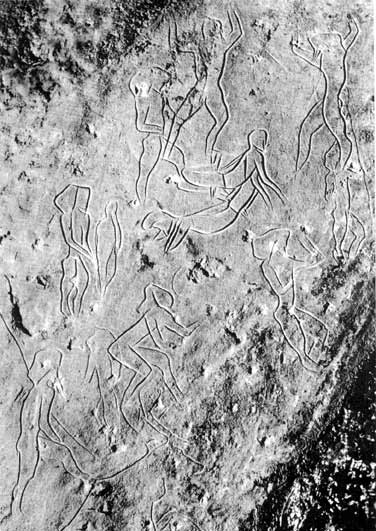
Engraved figures in the Addaura caves near Palermo 8000 BC(?)
Proto-Europe
8 000 - 5000 BC
Anatolian Civilization and the Indo-European Language
Spreads to Western Europe with Agriculture
Since the 1960 extensive research - in parts driven by the constrution of two new reservoirs on the Euphrates - have unearthed numerous sites less spectacular than the later, well-known Mesopotamian sites. They have revolutionized our understanding of the transition from hunting-gatherer societies to those dependent on agriculture and husbandry. The intersting aspect is that in several places large cities with 3-level buildings (e.g., Catalhüyük, Cayönü) predate the agrcultural transition. It must also be remembered that that these settlements predate Mesopotamia proper, Egypt and the Indus sites by more than 2000 years. Whether the flow of artifacts and culture to Proto-Europe, Malta, and Mesopotamia started from here, is still an open question.
Proto-European
Cultures
8000-2500 BC
Interactive map of the Proto-European cultures in the Balkans
It is now assumed that the pre Indo-European or Proto-European cultures which have evolved from rich archeological finds in the Greater Balkans, Greece and Sicily/Malta in the last 50 years go back to migrations from Anatolia.
The archeological objects found in the Greater Balkans by Marija Gimbutas and others show a high sophistication in sculptures, ornaments and grave culture. The "Proto-European Culture" in the Balkans and Greece is the oldest collective "civilization" known. They preceed Egypt by 4000 and China by 6000 years.
Several large urban settlements (20 000 people) have been found, posiibly under a female(?) priesthood.. The earliest temple cities have been unearthed in Göbekli (9200 BP) predating agriculture by 2000 years. The excavators believe that the large concentrations of laborers building the temples precipitated the need for agriculture.
Sicanian
Cultures
8000 BC
The Sicanians were the earliest known peoples to have inhabited Sicily, originally located in the west and central areas of the island. Cave drawings have been discovered in Addaura, near Palermo from the end of the Pleistocene Epoch, around 8000 BC

Engraved
figures in the Addaura caves near Palermo 8000 BC(?)
Sesklo
6850-5500
BC
Thessali, Greece
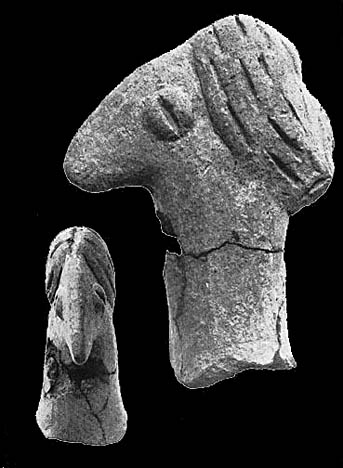
Bird-Goddess,
Seklo-Achileion, 6000 BC
photo Marija Gimbutas, “Goddesses and
Gods of Old Europe”, U of California, Berkeley,1982
The Sesklo Culture, Thessaly Greece 6850 BC-5500 BC is the first Neolithic culture of Europe. The oldest fragments researched at Sesklo place the civilization's development as far back as 6850 BC with a +/- 660 year margin of error. The first settlements, which predate the 6th millennium BC, are known as proto-Sesklo (main group) and pre-Sesklo (secondary groups with different characteristics) and they show an advanced agriculture and a very early use of pottery that rivals in age those of the Near East
The peoples of Sesklo built their villages on hillsides near fertile valleys, where they grew wheat and barley, also keeping herds of mainly sheep and goats, though they also had cows, pigs and dogs. Their houses were small, with one or two rooms, built of wood or mudbrick in the early period. Later the construction technique becomes more homogeneous and all homes are built of adobe with stone foundations. In the 6th millennium BC, the first houses with two levels are found and there is also a clear intentional urbanism.
Vinca
5300-3500
BC
Danube Basin
The Vinca culture was an early culture of Europe (6th-3rd millennium
BC), stretching around the course of Danube in Serbia, Croatia,
Romania, Bulgaria, and the Republic of Macedonia, with traces around
the Balkans, parts of Central Europe, and Asia Minor.
The
Neolithic settlers of Vinca ascribed great importance to spiritual
life as is reflected by their cult objects. Their anthropomorphic
figurines have a characteristic dignified stance and their number
(over 1000 examples at Vinca alone) exceeds the total number of
figurines discovered in the Greek Aegean. Shrines were discovered in
Parca Transylvania with complex architectural designs.
Some
figurines and ceramic dishes discovered in the broad region spanning
from Gornja Tuzla to Tartaria bear signs which some scholars suppose
to be primitive forms of writing.
|
|
|
|
|
|
Selection of the thousands of votive figures from Vinca, 15-18 cm,
clay, 5000 BC
photos Lessing
Photo Archive
Karanovo-Hamangia
5500-4500
BC
The region
ovelaps part of todays Hungary, Romania and Bulgaria
The highest Bulgarian tells have a stratigraphic depth of as much as 18 m., composed of accumulated debris from the sixth to the third millennia BC. The stratigraphies defined at the Karanovo, Azmak and Kazanlik tells yield an ideal documentation of the evolution and continuity of material culture over a long period; the Karanovo sequence, phases I to VI, has become universally adopted as a chronological yardstick for the development of East Balkan civiliza-tion during the sixth, fifth and part of the fourth millennia BC. A large number of radiocarbon dates from the Karanovo and Azmak tells, representing Karanovo I-III, form an almost perfect sequence; calibrated, they run from the end of the seventh millennium to about 5200 BC.
There was a considerable increase in population during the Karanovo
III phase, which must have begun around 5500-5400 BC, when elements
of the Karanovo III assemblage were carried, probably by ethnic
expansion, northwest into the lower Danube region and southward
beyond the Rhodope Mountains to Macedonia and Thrace. In the north
the intruders had to confront the settlers of the Central European
Linear Pottery culture, who occupied the lower Danube and the
Hamangia group on the Black Sea coast.
Text and photos from
Marija Gimbutas, “Goddeses and Gods of Old Europe, 6500 -3500 BC,
Myths and Cult Images”, University of California Press, 1982
Outstanding eamples of grave finds are the thinker and is wife, the figures from Pazardzik, and the gold treasure from Varna Necropolis
Cernavoda
5000 BC

The
Thinker and his Wife (from the same grave),
Cernavoda,
Karanovo Culture 5000 BC.
Arguably the most exciting sculptures of
the Balkan cultures.
These two clay statuettes from 5000 BC were found in 1956 in Cernavoda, Romania, in a tomb near the Danube. They come from the Hamangia culture, an early farming society emerging in the sixth millenium B.C. In what is today Romania.
Pazardzhik
4500
BC
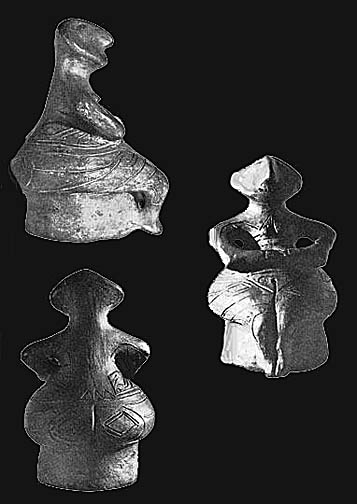
The
Lady of Pazardzhik (4500 BC)
Photos Marija Gimbutas, “Goddeses
and Gods of Old Europe, 6500 --3500 BC, Myths and Cult Images”,
University of California Press, 1982
The Gold Treasure of Varna Necropolis
4600-4200 BC

The
Gold Treasure of Varna 4600-4200 BC
Richly endowed skeleton with typical scepter (Grave 43). It contained more gold than had been found in the entire rest of the world for that epoch. Photo inme.bas.bg
The site was accidentally discovered in October 1972 by Raycho Marinov (1972-1991). 294 graves have been found in the necropolis, many containing sophisticated examples of metallurgy (gold and copper), pottery, high-quality flint and obsidian blades, beads, and shells.
The graves have been dated to 4600-4200 BC (radiocarbon dating, 2004) and belong to the Eneolithic Varna culture. Some graves do not contain a skeleton, but grave gifts (cenotaphs). Interestingly, the symbolic (empty) graves are the richest in gold artifacts. 3000 gold artifacts were found, with a weight of approximately 6 kilograms. Grave 43 (photo) contained more gold than has been found in the entire rest of the world for that epoch.
Tisza-Lengyel
5000-4000
BC
Middle Danube
The Tisza-Lengyel culture (Gimbutas), is an archaeological culture of the European Neolithic, centered on the Middle Danube in Central Europe. It flourished during ca. 5000–3000 BC. The eponymous type site is at Lengyel in Tolna county, Hungary.
It was a successor to the Linear pottery culture, and in its northern extent, overlapped the somewhat later but otherwise approximately contemporaneous to thr Funnelbeaker culture. Subgroups of the Lengyel horizon include the Austrian/Moravian Painted Ware I and II, Aichbühl, Jordanów/Jordanov/Jordansmühl, Schussenried, Gatersleben, etc
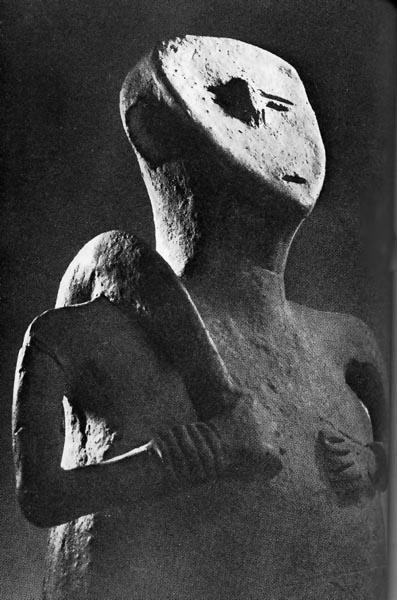
Seated
masked man holding a sichel, Szegvar, Tisza Culture, 5000 BC. An
exceptional photograph of another sophisticated male clay sculpture.
Photo from Marija Gimbutas, “Goddeses and Gods of Old Europe,
6500 --3500 BC, Myths and Cult Images”, University of California
Press, 1982
Szegvar 5000-4000 BC
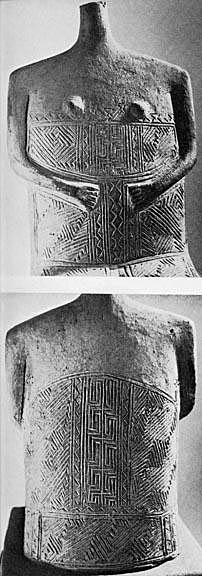
The
"Szegvar enthroned Goddess of the Fields", Tisza Culture,
5000 BC.
Photo from Marija Gimbutas, op.cit.
Cucuteni-Tripolye
5000-3500
BC
Rumenia, Ukraine
The Cucuteni-Trypillian culture, also known as Cucuteni culture (from Romanian), Trypillian culture (from Ukrainian) or Tripolye culture (from Russian), is a Neolithic–Eneolithic archaeological culture which existed from approximately 4800 to 3000 BC, from the Carpathian Mountains to the Dniester and Dnieper regions in modern-day Romania, Moldova, and Ukraine. Novel technologies invented here (as well as elsewhere) were plowshares made from antlers and the 4-wheel wagon:
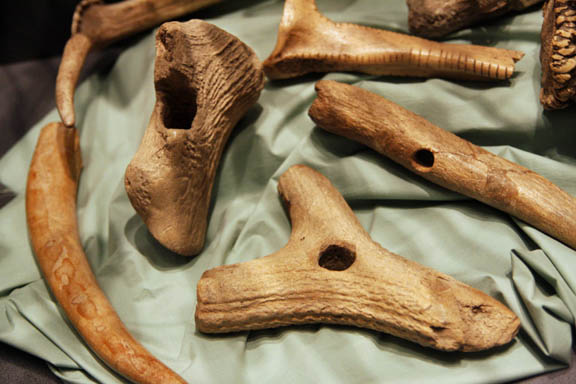
Plough
Shares from antlers and mammoth bones
The majority of Cucuteni-Trypillian settlements consisted of high-density, small settlements (spaced 3 to 4 kilometers apart), concentrated mainly in the Siret, Prut, and Dniester river valleys.
One of the most notable aspects of this culture was the periodic
destruction of settlements, with each single-habitation site having a
roughly 60 to 80 year lifetime. The purpose of burning these
settlements is a subject of debate among scholars; some of the
settlements were reconstructed several times on top of earlier
habitational levels, preserving the shape and the orientation of the
older buildings. One particular location, the Poduri site (Romania),
revealed thirteen habitation levels that were constructed on top of
each other over many years.
Wikipedia
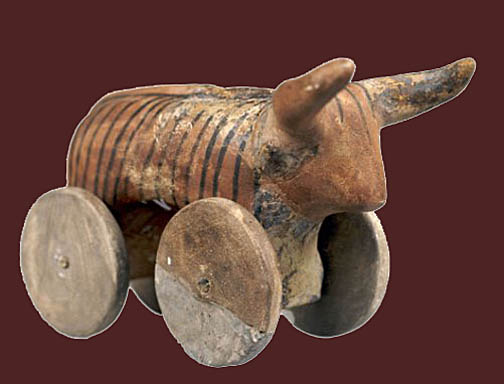
A
toy(?) - with wheels! (3000 BC)
Evidence of wheeled vehicles appears from the mid-4th millennium BC, near-simultaneously in Mesopotamia, the Northern Caucasus (Maykop culture) and Central Europe, so that the question of which culture originally invented the wheeled vehicle remains unresolved and under debate.
The earliest well-dated depiction of a wheeled vehicle (here a wagon—four wheels, two axles), is on the Bronocice pot, a ca. 3500–3350 BC clay pot excavated in a Funnelbeaker culture settlement in southern Poland.
The wheeled vehicle spread from the area of its first occurrence
(Mesopotamia, Caucasus, Balkans, Central Europe) across Eurasia,
reaching the Indus Valley by the 3rd millennium BC. During the 2nd
millennium BC, the spoke-wheeled chariot spread at an increased pace,
reaching both China and Scandinavia by 1200 BC. In China, the wheel
was certainly present with the adoption of the chariot in ca. 1200
BC.
Wikipedia
Malta
Sites
3600-2000 BC
5000 yers after Göbeklik five similar temple structures appear on Malta
The Megalithic Temples of Malta are a series of prehistoric monuments in the Maltese archipelago. Archaeologists believe that these megalithic complexes are the result of local innovations in a process of cultural evolution. This led to the building of several temples of the Ggantija phase (3600-3000 BC) and culminated in the large Tarxien temple complex, which remained in use until 2500 BC. After this date, the temple building culture disappeared.
Gozo Island, Ggantija
Temple
3600-2500 BC
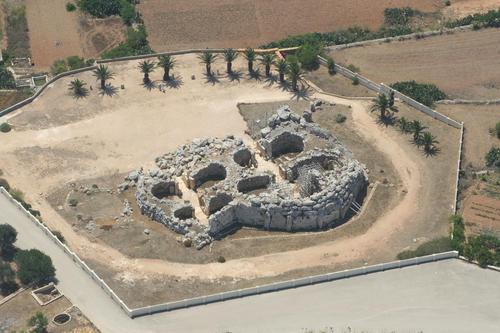
The
Gggantija Temple on Gozo Island, Malta
The Ggantija temples are the earliest of a series of megalithic temples in Malta. Their makers erected the two temples during the Neolithic Age (c. 3600-2500 BC), which makes these temples more than 5500 years old and some of the world's oldest manmade religious structures
This megalithic monument is in fact two temples, built side by side
and enclosed within a boundary wall. The southerly one is the larger
and elder, dating back to approximately 3600 BC. It is also better
preserved. The plan of the temple incorporates five large apses, with
traces of the plaster that once covered the irregular wall still
clinging between the blocks. - Evidence of animal bones in the site
suggests the site was used for animal sacrifice.
Wikipedia
Mnajdra Megalithic
Temple
3600-2500 BC
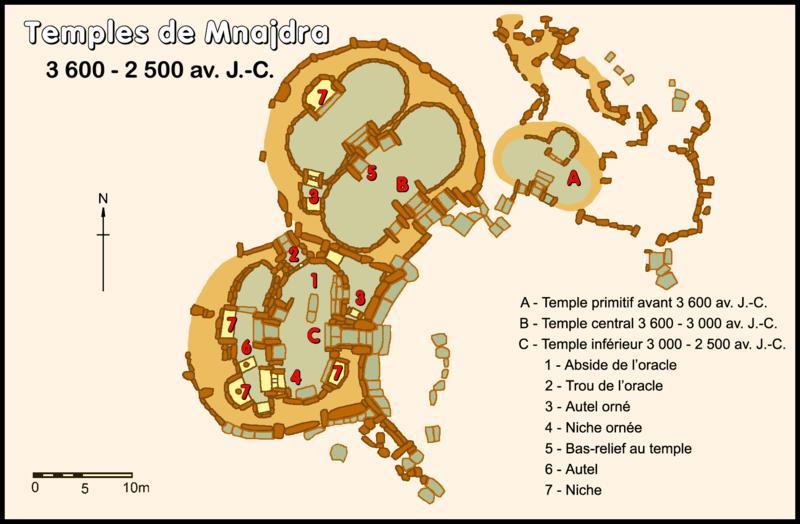
Plan
of the thre temples at Mnajdra 4000 BC
Mnajdra is a megalithic temple complex found on the southern coast of
the Mediterranean island of Malta. Mnajdra is approximately 500
metres from the Ħaġar Qim megalithic complex. Mnajdra was built
around the fourth millennium BCE; the Megalithic Temples of Malta are
amongst the most ancient religious sites on Earth, described by the
World Heritage Sites committee as "unique architectural
masterpieces”.
Wikipedia
Hagar Qim, Malta
3200 BC
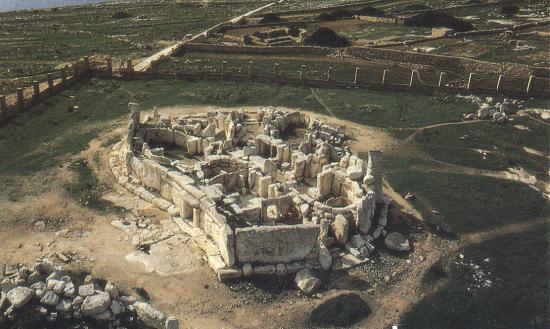
The
temple complex at Hagar Qim
Hagar Qim, the temple was built during the Tarxien phase, between
3000 BC and 2500 BC. The floor plan seems less regular than its
predecessor at Ggantija. Six large, circular rooms are connected by
an interior passage. Most of the rooms also have outside entrances,
and an open-air shrine is set into the outer wall. Hagar Qim is
notable for its impressive and finely-smoothed entrance facade, for
the huge stone blocks used in its construction, and for its
associated artifacts: the "Venus of Malta" and other female
statuettes, and a four-sided altar with plant carvings.
Wikipedia
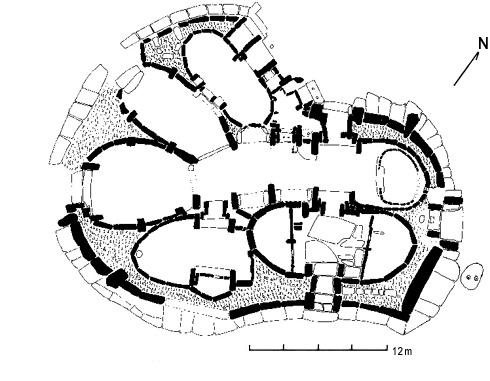
Plan
of Hagar Qim 3000 BC
Tarxien Temple Complex
3150 –
2500 BC
The Tarxien consist of three separate, but attached, temple structures. The main entrance is a reconstruction dating from 1956, when the whole site was restored. At the same time, many of the decorated slabs discovered on site were relocated indoors for protection at the Museum of Archaeology in Valletta. The first temple has been dated to approximately 3100 BC and is the most elaborately decorated of the temples of Malta. The middle temple dates to about 3000 BC, and is unique in that, unlike the rest of the Maltese temples, it has three pairs of apse instead of the usual two. The east temple is dated at around 3100 BC. The remains of another temple, smaller, and older, having been dated to 3250 BC, are visible further towards the east
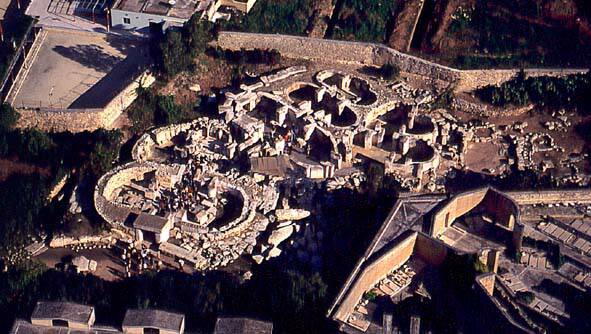
The
Tarxien Complex
The temples were used extensively for rituals, which probably
involved animal sacrifice. Additionally, evidence of cremation has
been found at the center of the South temple, which is an indicator
that the site was reused as a Bronze Age cremation
cemetery.
Wikipedia